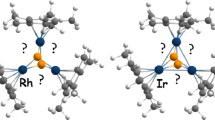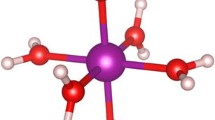Abstract
The nuclear magnetic shieldings of Si, Ge, and Sn in MH4−n Y n (M = Si, Ge, Sn; Y = F, Cl, Br, I and n = 1–4) molecular systems are highly influenced by the substitution of one or more hydrogens by heavy-halogen atoms. We applied the linear response elimination of small components (LRESC) formalism to calculate those shieldings and learn whether including only a few of the leading relativistic correction terms is sufficient to be able to quantitatively reproduce the full relativistic value. It was observed that the nuclear magnetic shieldings change as the number of heavy halogen substituents and their weights vary, and the pattern of σ(M) generally does not exhibit the normal halogen dependence (NHD) behavior that can be seen in similar molecular systems containing carbon atoms. We also analyzed each relativistic correction afforded by the LRESC method and split them in two: core-dependent and ligand-dependent contributions; we then looked for the electronic mechanisms involved in the different relativistic effects and in the total relativistic value. Based on this analysis, we were able to study the electronic mechanism involved in a recently proposed relativistic effect, the “heavy atom effect on vicinal heavy atom” (HAVHA), in more detail. We found that the main electronic mechanism is the spin–orbit or σ T(3)p correction, although other corrections such as σ S(1)p and σ S(3)p are also important. Finally, we analyzed proton magnetic shieldings and found that, for molecules containing Sn as the central atom, σ(H) decreases as the number of heavy halogen substituents (of the same type: either F, Cl, or Br) increases, albeit at different rates for different halogens. σ(H) only increase as the number of halogen substituents increases if the halogen is iodine.










Similar content being viewed by others
References
Edlund U, Lejon T, Pyykkö P, Venkatachalam TK, Buncel E (1987) J Am Chem Soc 109:5982
Pyykkö P, Görling A, Rösch N (1987) Mol Phys 61:195
Kaupp M, Malkina OL, Malkin VG, Pyykkö P (1998) Chem Eur J 4:118
Melo JI, Ruiz deAzúa MC, Giribet CG, Aucar GA, Provasi PF (2004) J Chem Phys 121:6798
Kaupp M (2004) Relativistic effects on NMR chemical shifts (Chapter 9). In: Schwerdtfeger P (ed) Relativistic electronic structure theory, part 2: applications. Elsevier, Amsterdam, pp 552–597
Lantto P, Romero RH, Gomez SS, Aucar GA, Vaara J (2006) J Chem Phys 125:184113
Vaara J (2007) Phys Chem Chem Phys 9:5399
Maldonado AF, Aucar GA (2009) Phys Chem Chem Phys 11:5615
Autschbach J, Zheng S (2009) Annu Rep NMR Spectrosc 67:1
Kantola AM, Lantto P, Vaara J, Jokisaari J (2010) Phys Chem Chem Phys 12:2679
Arcisauskaite V, Melo JI, Hemmingsen L, Sauer SPA (2011) J Chem Phys 135:044306
Roukala J, Maldonado AF, Vaara J, Aucar GA, Lantto P (2011) Phys Chem Chem Phys 13:21016
Melo JI, Maldonado AF, Aucar GA (2012) J Chem Phys 137:214319
Melo JI, Maldonado AF, Aucar GA (2011) Theor Chem Accounts 129:483
Melo JI, Ruiz deAzúa MC, Giribet CG, Aucar GA, Romero RH (2003) J Chem Phys 118:471
Manninen P, Lantto P, Vaara J, Ruud K (2003) J Chem Phys 119:2623
Manninen P, Ruud K, Lantto P, Vaara J (2005) J Chem Phys 122:114107
Rodriguez-Fortez A, Alemany P, Ziegler T (1999) J Phys Chem A 103:8288
Maldonado AF, Aucar GA (2014) J Phys Chem A. doi:10.1021/jp502543m
Gomez SS, Maldonado AF, Aucar GA (2005) J Chem Phys 123:214108
Visscher L, Enevoldsen T, Saue T, Jensen HJA, Oddershede J (1999) J Comput Chem 20:1262
Jameson CJ (1998) Multinuclear NMR. Plenum, New York
Kaupp M (2004) Interpretation of NMR chemical shifts (Chapter 18). In: Kaupp M, Bühl M, Malkin VG (eds) Calculation of NMR and EPR parameters: theory and applications. Wiley-VCH, Weinheim, pp 293–306
Fukawa S, Hada M, Fukuda R, Tanaka S, Nakatsuji H (2001) J Comput Chem 22:528
Aucar GA, Romero RH, Maldonado AF (2010) Int Rev Phys Chem 29:1
Saue T, Visscher L, Bast R, Jensen HJA, Dyall KG, Ekstrom U, Eliav E, Enevoldsen T, Fleig T, Gomes ASP, Henriksson J, Iliaš M, Jacob CR, Knecht S, Nataraj HS, Norman P, Olsen J, Pernpointner M, Ruud K, Schimmelpfennig B, Sikkema J, Thorvaldsen A, Thyssen J, Villaume S, Yamamoto S (2010) DIRAC10. University of Southern Denmark, Odense. http://dirac.chem.sdu.dk
Kagakkai NB (1984) Kagaku benran, 3rd edn. Maruzen, Tokyo, p 649
Sadlej AJ (1991) Theor Chim Acta 79:123
Maldonado AF, Gimenez CA, Aucar GA (2012) Chem Phys 395:75
Maldonado AF, Gimenez CA, Aucar GA (2012) J Chem Phys 136:224110
Aidas K, Angeli C, Bak KL, Bakken V, Bast R, Boman L, Christiansen O, Cimiraglia R, Coriani S, Dahle P, Dalskov EK, Ekström U, Enevoldsen T, Eriksen JJ, Ettenhuber P, Fernández B, Ferrighi L, Fliegl H, Frediani L, Hald K, Halkier A, Hättig C, Heiberg H, Helgaker T, Hennum AC, Hettema H, Hjertenæs E, Høst S, Høyvik I-M, Iozzi MF, Jansík B, Jensen HJA, Jonsson D, Jørgensen P, Kauczor J, Kirpekar S, Kjærgaard T, Klopper W, Knecht S, Kobayashi R, Koch H, Kongsted J, Krapp A, Kristensen K, Ligabue A, Lutnæs OB, Melo JI, Mikkelsen KV, Myhre RH, Neiss C, Nielsen CB, Norman P, Olsen J, Olsen JMH, Osted A, Packer MJ, Pawlowski F, Pedersen TB, Provasi PF, Reine S, Rinkevicius Z, Ruden TA, Ruud K, Rybkin VV, Sałek P, Samson CCM, Sánchez de Merás A, Saue T, Sauer SPA, Schimmelpfennig B, Sneskov K, Steindal AH, Sylvester-Hvid KO, Taylor PR, Teale AM, Tellgren EI, Tew DP, Thorvaldsen AJ, Thøgersen L, Vahtras O, Watson MA, Wilson DJD, Ziolkowski M, Ågren H (2013) The Dalton quantum chemistry program system. WIREs Comput Mol Sci 4:269–284. doi:10.1002/wcms.1172
Kaneko H, Hada M, Nakajima T, Nakatsuji H (1996) Chem Phys Lett 261:1
Acknowledgments
We gratefully acknowledge support from both the Argentinian National Agency for Promoting Science and Technology (FONCYT, PICT2012-1214) and Secretaría General de Ciencia y Técnica de la Universidad Nacional del Nordeste, SeCyT-UNNE (PI 17/12T001). J.I.M. gratefully acknowledges support from the Argentinian National Research Council for Science and Technology (CONICET, grant PIP 0369 and UBACYT W105).
Author information
Authors and Affiliations
Corresponding author
Additional information
This paper belongs to Topical Collection Brazilian Symposium of Theoretical Chemistry (SBQT2013)
Electronic supplementary material
Below is the link to the electronic supplementary material.
ESM 1
(PDF 93 kb)
Rights and permissions
About this article
Cite this article
Maldonado, A.F., Aucar, G.A. & Melo, J.I. Core-dependent and ligand-dependent relativistic corrections to the nuclear magnetic shieldings in MH4−n Y n (n = 0–4; M = Si, Ge, Sn, and Y = H, F, Cl, Br, I) model compounds. J Mol Model 20, 2417 (2014). https://doi.org/10.1007/s00894-014-2417-z
Received:
Accepted:
Published:
DOI: https://doi.org/10.1007/s00894-014-2417-z




